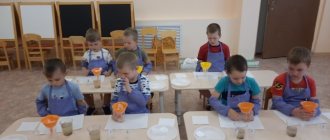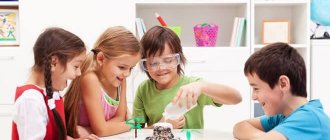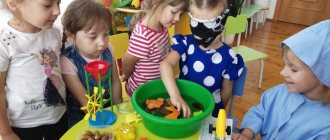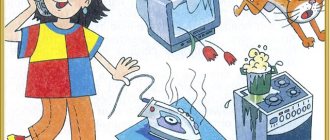Comprehensive thematic planning for experimentation for children 4-5 years old
| Month | No. A week | Subject | Goals and objectives | Content | Literature |
| September | 1 | We smell, we taste, we touch, we listen | To consolidate children's understanding of the senses, their meaning (ears - to hear, recognize various sounds; nose - to detect smell) | Game "Guess what it sounds like" Game "Guess by smell" | Experimental activity author Tugusheva G.P. Chistyakova A.E.St9 |
| September | 2 | We smell, we taste, we touch, we listen | Continue to consolidate children’s ideas about the senses, their meaning (fingers - determine the shape, surface structure; tongue - determine the taste) | Game "Guess the taste" Game “Guess by touch” | Experimental activity author Tugusheva G.P. St9 |
| September | 3 | Why does everything sound? | Bring children to understand the causes of sound: vibration of an object. | Game "What does it sound like?" | Experimental activities Tugusheva G.P. St10 |
| September | 4 | Why does everything sound? | Bring children to understand the causes of sound: vibration of an object. | Game "What does it sound like?" | Experimental activities Tugusheva G.P. St10 |
Development of cognitive and research activities.
Explanatory note
The section “Development of cognitive and research activities” is also an integral part of the educational direction “Cognition”. Children's research projects are an effective and didactically justified teaching method. Research activities develop children’s cognitive activity, teach them to act independently, plan work and bring it to a positive result, and show initiative and creativity.
The main goal of this section is to develop the need for research activities in preschool children.
The goal is achieved through solving the following tasks:
— creating methodologically competent conditions for children’s experimentation in the classroom and in children’s independent creative activities;
— developing the ability to formalize the results of research activities;
— creating conditions for the presentation of research results;
— involving parents in participating in the child’s research activities.
At the end of the year, children can:
• independently repeat the experiments done together with adults;
• to make plan
research work, making diagrams and sketches;
• compare the results of observations, compare, analyze, draw conclusions and generalizations
| Month | No. A week | Subject | Goals and objectives | Content | Literature |
| October | 5 | Clear water | Identify the properties of water (transparent, odorless, pours, has weight). | Game “Who is this droplet? What does she like to play with?”Game “Find out and name” Game “What kind of water?” | Experimental activity author Tugusheva G.P. St11 |
Long-term planning of cognitive-experimental activities (middle group)
Transcript
1 October September Long-term planning of cognitive-experimental activities (middle group) Section Object Name and purpose of the experiment Living Plants “Which flowers last longer: cut or left on the plant?” Purpose: To help determine that cut plants live less than on the root, but open later than those left with the root. Familiarize yourself with the condition of the soil; develop observation and curiosity. Water “Colored Droplets” Purpose: To teach to observe the “journey” of a droplet. Materials: Jar of water, pipette, paints. “Soap Bubbles” Purpose: Perception of size, ability to compare; tactile sensations; speech breathing, emotional perception. Material: Basin, water; soap foam, baby shampoo, cocktail straw. Glass. “Glass, its qualities and properties.” Goal: To teach children to recognize objects made of glass; determine its qualities (surface structure, thickness, transparency) and properties (fragility, thermal conductivity). Material: Glass cups and tubes, colored water, algorithm for describing the properties of the material. Living Human Olfactory organ. "Smart Nose" Goal: To get acquainted with the features of the nose. Identify objects by smell. Material: Various flowers, products with a characteristic odor, containers containing odorous substances, pictures depicting the corresponding products. Air "Search for air." Goal: Help children discover the air around them. Material: Water, plumes, ribbons, flags, bag, balloon, cocktail straws, container. Sound "Why does everything sound?" Goal: to lead children to understand the causes of sound: vibration of an object Paper “World of Paper”
2 December November Purpose: To introduce different types of paper (napkin, writing, wrapping, drawing); develop the ability to compare the quality characteristics and properties of paper. Living Plant Seeds “Who has which babies.” Purpose: To highlight the common features of the structure of seeds (presence of a nucleolus). Encourage them to name the parts of the structure of seeds: nucleolus, shell. Materials: Vegetables, fruits, berries, trays, magnifying glass, hammer, images of plants, collection of seeds. Sand Clay “Why does sand flow well”? Purpose: To highlight the properties of sand and clay: flowability, friability. Material: Containers with sand and clay; containers for pouring; magnifying glass, sieve. Buoyancy “Tone - doesn’t sink” Purpose: To test the “buoyancy” of different toys made of different materials. Material: Plastic and wooden cubes, iron machine, wooden ball, container with water. Fabric “World of Fabric” Purpose: To introduce different types of fabrics; help to understand that the properties of a material determine the way it is used. Living Fur “Why does a bunny need another fur coat?” Goal: To identify the dependence of changes in the lives of animals on changes in inanimate nature. Materials: Pieces of dense and rare fur, mittens made of thin, dense fabric and fur. Snow "Let's take a snowman with us." Purpose: To give children the idea that snow and ice melt in warmth and water is formed. Establish the dependence of changes in nature on the season. Material: Snowman with an icicle nose, container. "Dance of the Peas." Purpose: To introduce the concept of “force of movement”; develop observation, curiosity, ingenuity. Material: Water, peas, straw, napkin. Rubber. Rubber, its qualities and properties." Goal: To recognize things made of rubber, to determine its qualities (surface structure, thickness) and properties (density, elasticity, elasticity),
3 March February January Light and shadow Material: Rubber objects: ribbons, toys, tubes. “Light and Shadow” Purpose: to introduce the formation of shadows from objects, to establish the similarity between a shadow and an object, to create images using shadows. Water "Making colored ice floes." Purpose: To introduce the two states of aggregation of water - solid and liquid. Identify the properties and qualities of water: it turns into ice (freezes in the cold, takes the shape of the container in which it is located). Material: A container with colored water, various molds, strings. Sun rays "Black and white". Purpose: To introduce the influence of sunlight on black and white; develop observation and ingenuity. Material: Napkins made of black fabric in black and white. Living organ of touch. "The tongue is a helper." Purpose: To introduce the meaning of language, to practice determining the taste of products. Material: A set of various food products (bitter, sweet, sour, salty taste). Ice "Liberation from Captivity." Purpose: Observe different defrosting methods. Material: Ice figures. Magnet "Magic mitten". Goal: Find out the ability of a magnet to attract certain objects. Material: Magnet, small items made of different materials, mitten with a magnet inside. Plas Purpose: To help determine the properties of plastic (smooth, rough), plastic products Living Plants “What do plants love”? Purpose: To identify the importance of moisture for the growth and life of plants. Material: Bulbs in a dry jar and in a jar with water. Light Sun rays “Rainbow” Purpose: Demonstrate a simple experiment, develop thinking and the ability to analyze.
4 May April Warmth Metal Material: Mirror, water, sun rays. “Water can be warm, cold, hot” Purpose: To make it clear that water in reservoirs has different temperatures, depending on the temperature of the water, different plants and animals live in reservoirs. Material: Water - cold, warm, hot, three pieces of ice “Metal, its qualities and properties.” Goal: Recognize objects made of metal, determine its qualitative characteristics (surface structure, color) and properties (thermal conductivity, metallic luster). Material: Metal objects, magnets, containers with water Living Plants “Tricky Seeds”. Purpose: To introduce the method of germinating seeds. Materials: Seeds of beans, zucchini, two jars of soil, a stick, a watering can, a gauze napkin. Stones Each pebble has its own home” Purpose: classification of stones by shape, size, color, surface features (smooth, rough); Show children the possibility of using stones for play purposes. "Where does the rain come from"? Goal: To draw children’s attention to interesting things, to conduct a simple experiment, to develop thinking. Material: Jar, hot water, lid, ice. Fabric “Tanya’s doll’s outfits” Purpose: To introduce different types of fabrics; help to understand that the properties of a material determine the way it is used. Living Plants “What do plants love”? Goal: Identify the need for light in plant life. Material: Two sets of plants, cardboard box. Sand Clay “Where is the water”? Goal: Reveal that sand and clay absorb water differently. Material: Transparent containers with dry sand, dry clay, measuring cups with water. Optics “How to raise a unit”? Purpose: To introduce the optical property of a mirror to divide images into two equal parts, with the concept of optics.
5 “Fun Stripe” paper. Purpose: To introduce the properties of paper and the effects of air on it; develop curiosity. Material: Strip of soft paper.



